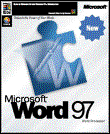

 There is no need to
purchase special software to compose nurses' notes on
a computer! I
have a Gateway Pentium-75 in the Student Health Center at
Pitt-Bradford, and I use Microsoft
Word for composing nurses notes. I create a document and type
nurses' notes in S.O.A.P.E. format on every patient visit to the
health
service. S.O.A.P.E. stands for Subjective
data, Objective data, Assessment, Plan of
care, treatment, and/or referral, and Evaluation. I have found
that the AutoText function in Microsoft Word is an invaluable
tool for quick and thorough documentation of student health treatment
plans. AutoText
is located under Edit in the Menu bar at the top of the screen in
Microsoft Word 6.0 or under Insert in the Menu bar of Word 97.
There is no need to
purchase special software to compose nurses' notes on
a computer! I
have a Gateway Pentium-75 in the Student Health Center at
Pitt-Bradford, and I use Microsoft
Word for composing nurses notes. I create a document and type
nurses' notes in S.O.A.P.E. format on every patient visit to the
health
service. S.O.A.P.E. stands for Subjective
data, Objective data, Assessment, Plan of
care, treatment, and/or referral, and Evaluation. I have found
that the AutoText function in Microsoft Word is an invaluable
tool for quick and thorough documentation of student health treatment
plans. AutoText
is located under Edit in the Menu bar at the top of the screen in
Microsoft Word 6.0 or under Insert in the Menu bar of Word 97.
There are certain phrases and protocols of treatment that I use repeatedly in charting. They are standard and consistent. Rather than typing them letter by letter each time, I created customized entries in Auto Text, which can be added to any patient's chart with a few keystrokes or mouse clicks. It is nice not to have to think about the spelling of "Pseudoephedrine" every time I add it to a patient's chart.
Here is a hypothetical example of a student chart:
SMITH, SUSAN
NO KNOWN ALLERGIES TO MEDS
9/4/97
S. C/O SORE THROAT AND SINUS CONGESTION FOR THE PAST 3 DAYS. CLEAR SINUS DRAINAGE FOR THE PAST 2 DAYS. SLIGHT COUGH WHICH IS NON-PRODUCTIVE.
O. TEMP 98.2. THROAT AND TONSILS RED, NO EXUDATE. CHEST SOUNDS CLEAR. NO REDNESS IN EAR CANALS NOR ON EARDRUMS.
A. DISCOMFORT FROM URI SYMPTOMS
P. ADVISED WARM SALINE GARGLES, CHERRY PHENOL THROAT LOZENGES, SIP WARM LIQUIDS, INCREASE REST AND FLUIDS. , ACETAMINOPHEN AS DIRECTED. BRUSH WHITISH COATING OFF OF TONGUE AFTER BRUSHING TEETH. MEDICIDIN-D AS DIRECTED. RETURN IF NO IMPROVEMENT. WATCH COLOR OF MUCUS. IF IT BECOMES YELLOW OR GREEN, RETURN.
CAROL MULVIHILL, R.N., C.
Some of the phrases listed under P. for plan of care and treatment are elements that I document repeatedly in the plan of care for complaints of sore throat. I save commonly used phrases like this in AutoText, to avoid retyping the entire entry each time I chart.
Here is how to save a frequently used phrase or paragraph within AutoText:
For example, under P. in the plan of care for a sore throat, I used the letter "T" to remind me it is for "throat." I could have used the entire word "throat" as the name of the entry, but I try to make the nicknames as short and pertinent as possible. However, if several staff are using the entries, it might be beneficial to use a word that is self-explanatory rather than a letter.
Every subsequent time you have to enter that same phrase, sentence or paragraph in a chart, you can insert it automatically by using AutoText. Using your mouse, select Edit or Insert, select AutoText, and type or select the abbreviated nickname or letter which you gave to the entry. Then click on Insert or press Enter, and the entire phrase will be added to your document. Once you have done this a few times, it gets quicker and easier. You can even do this by using a few keystrokes instead of the mouse. Either way, creating customized AutoText entries saves time and produces a consistent and accurate chart entry.
I have more than forty customized entries in AutoText, which I and my part-time nurse use for documentation of student health visits. Here are a few examples of some of the charting phrases I have saved in AutoText and the abbreviations I gave them:
NKA
NO KNOWN ALLERGIES TO MEDICATIONS
T
ADVISED WARM SALINE GARGLES, CHERRY PHENOL THROAT LOZENGES, SIP
WARM LIQUIDS, INCREASE REST AND FLUIDS. ACETAMINOPHEN AS DIRECTED.
BRUSH WHITISH COATING OFF OF TONGUE AFTER BRUSHING TEETH.
NA
CALLED DR. NADELLA: HE ORDERED AMOXICILLIN 250MG. TID X 10 DAYS.
R
RETURN IF NO IMPROVEMENT.
RP
RETURN IN 2-3 DAYS TO REPORT PROGRESS.
ANKLE
WRAPPED ANKLE WITH 4" ELASTIC BANDAGE. ADVISED ICE, REST, AND ELEVATION.
IBUPROFEN AS DIRECTED TO RELIEVE PAIN AND SWELLING. FITTED FOR CRUTCHES
AND INSTRUCTED IN USE. RETURN IN 2-3 DAYS FOR RECHECK.
CM
CAROL MULVIHILL, R.N., C.
Even if you are new to documentation of student health services visits on a computer, I encourage you to experiment with AutoText. Once you get the hang of it and realize what a convenient time-saver it is, you will use it regularly. It may become your favorite shortcut for documenting nurses' notes in on the computer!
